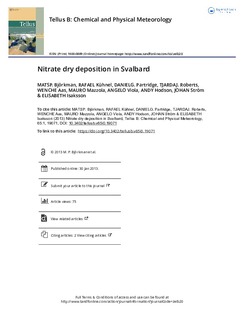| dc.contributor.author | Björkman, Mats Peter | |
| dc.contributor.author | Kühnel, Rafael | |
| dc.contributor.author | Partridge, Daniel G. | |
| dc.contributor.author | Roberts, Tjarda | |
| dc.contributor.author | Aas, Wenche | |
| dc.contributor.author | Mazzola, Mauro | |
| dc.contributor.author | Viola, Angelo | |
| dc.contributor.author | Hodson, Andy | |
| dc.contributor.author | Ström, Johan | |
| dc.contributor.author | Isaksson, Elisabeth | |
| dc.date.accessioned | 2018-04-26T11:18:27Z | |
| dc.date.available | 2018-04-26T11:18:27Z | |
| dc.date.created | 2013-06-04T13:14:58Z | |
| dc.date.issued | 2013 | |
| dc.identifier.citation | Björkman, M.P., Kühnel, R., Partridge, D.G., Roberts, T.J., Aas, W., Mazzola, M., Viola, A., Hodson, A., Ström, J., Isaksson, E. (2013). Nitrate dry deposition in Svalbard. Tellus B, 65, 19071, doi:10.3402/tellusb.v65i0.19071 | nb_NO |
| dc.identifier.issn | 0280-6509 | |
| dc.identifier.uri | http://hdl.handle.net/11250/2496119 | |
| dc.description.abstract | Arctic regions are generally nutrient limited, receiving an extensive part of their bio-available nitrogen from the deposition of atmospheric reactive nitrogen. Reactive nitrogen oxides, as nitric acid (HNO3) and nitrate aerosols (p-NO3), can either be washed out from the atmosphere by precipitation or dry deposited, dissolving to nitrate (). During winter, is accumulated in the snowpack and released as a pulse during spring melt. Quantification of deposition is essential to assess impacts on Arctic terrestrial ecology and for ice core interpretations. However, the individual importance of wet and dry deposition is poorly quantified in the high Arctic regions where in-situ measurements are demanding. In this study, three different methods are employed to quantify dry deposition around the atmospheric and ecosystem monitoring site, Ny-Ålesund, Svalbard, for the winter season (September 2009 to May 2010): (1) A snow tray sampling approach indicates a dry deposition of –10.27±3.84 mg m−2 (± S.E.); (2) A glacial sampling approach yielded somewhat higher values –30.68±12.00 mg m−2; and (3) Dry deposition was also modelled for HNO3 and p-NO3 using atmospheric concentrations and stability observations, resulting in a total combined nitrate dry deposition of –10.76±1.26 mg m−2. The model indicates that deposition primarily occurs via HNO3 with only a minor contribution by p-NO3. Modelled median deposition velocities largely explain this difference: 0.63 cm s−1 for HNO3 while p-NO3 was 0.0025 and 0.16 cm s−1 for particle sizes 0.7 and 7 µm, respectively. Overall, the three methods are within two standard errors agreement, attributing an average 14% (total range of 2–44%) of the total nitrate deposition to dry deposition. Dry deposition events were identified in association with elevated atmospheric concentrations, corroborating recent studies that identified episodes of rapid pollution transport and deposition to the Arctic. | nb_NO |
| dc.language.iso | eng | nb_NO |
| dc.rights | Navngivelse-Ikkekommersiell 4.0 Internasjonal | * |
| dc.rights.uri | http://creativecommons.org/licenses/by-nc/4.0/deed.no | * |
| dc.title | Nitrate dry deposition in Svalbard | nb_NO |
| dc.type | Journal article | nb_NO |
| dc.type | Peer reviewed | nb_NO |
| dc.description.version | publishedVersion | nb_NO |
| dc.rights.holder | © 2013 M. P. Björkman et al. | nb_NO |
| dc.source.pagenumber | 18 | nb_NO |
| dc.source.volume | 65 | nb_NO |
| dc.source.journal | Tellus. Series B, Chemical and physical meteorology | nb_NO |
| dc.identifier.doi | 10.3402/tellusb.v65i0.19071 | |
| dc.identifier.cristin | 1032365 | |
| dc.relation.project | NILU: 113008 | nb_NO |
| dc.relation.project | NILU: 113007 | nb_NO |
| dc.relation.project | EC/FP7/215503 | nb_NO |
| cristin.unitcode | 7460,57,0,0 | |
| cristin.unitname | Atmosfære og klima | |
| cristin.ispublished | true | |
| cristin.fulltext | original | |
| cristin.qualitycode | 1 | |

